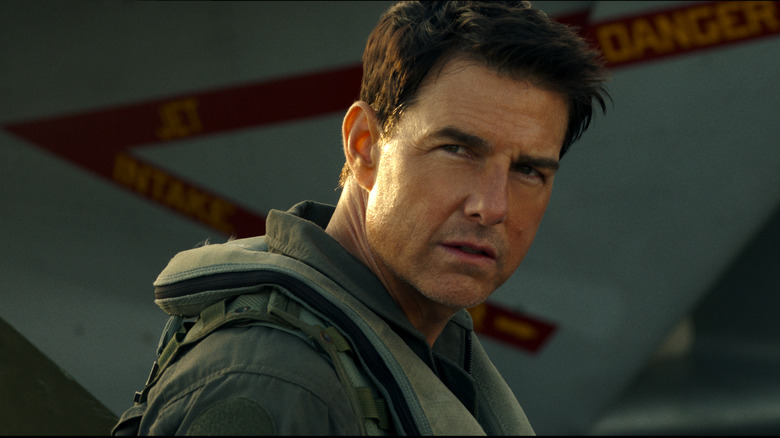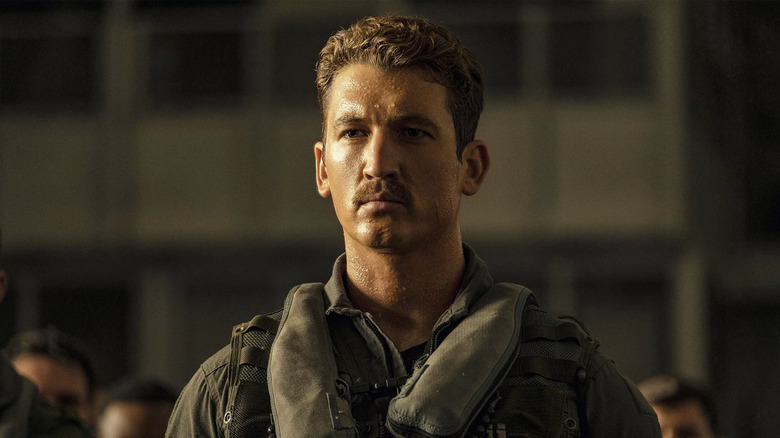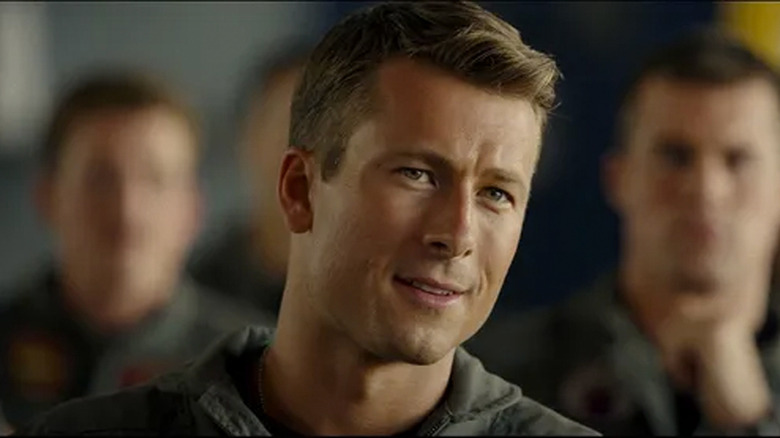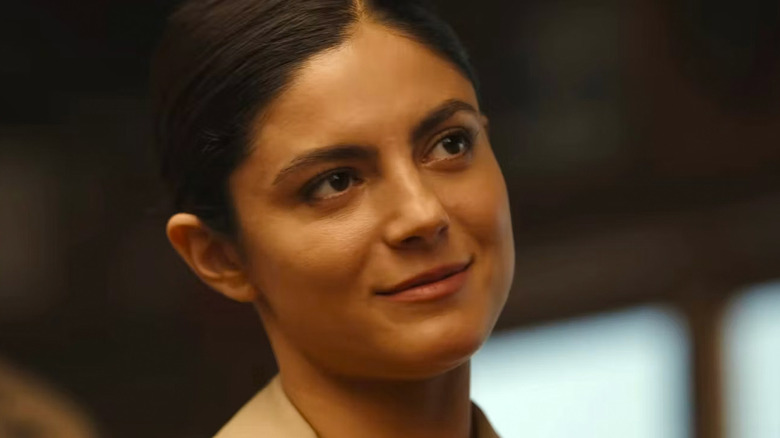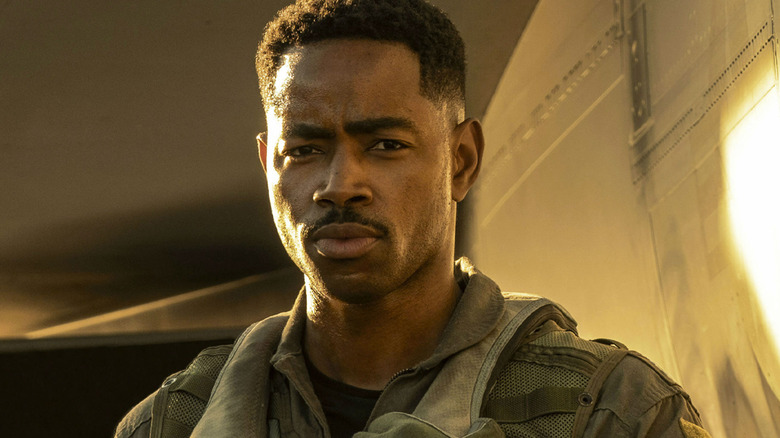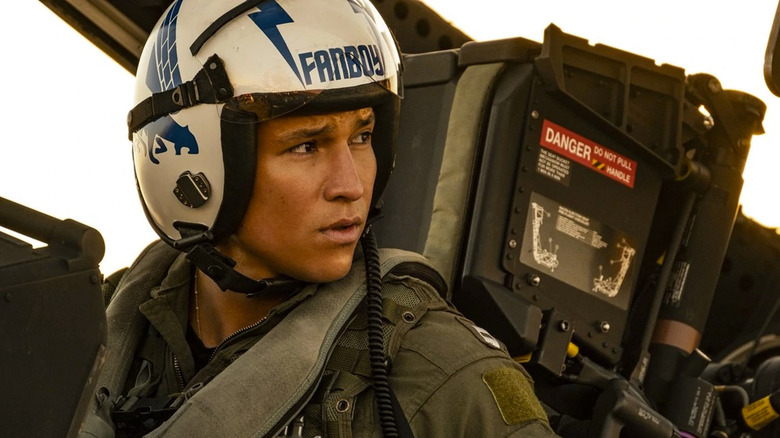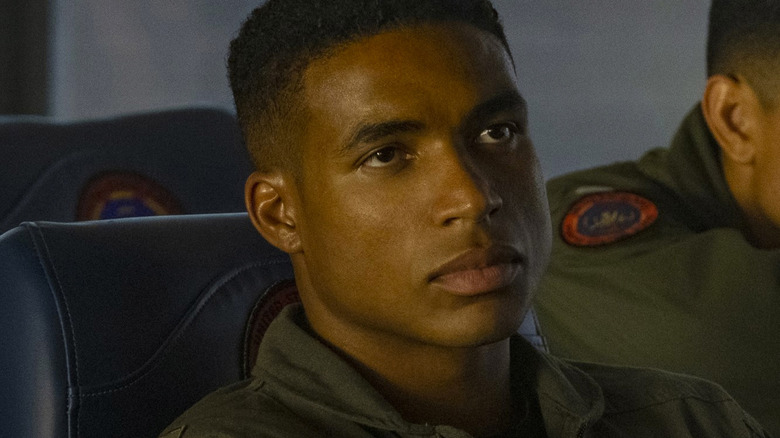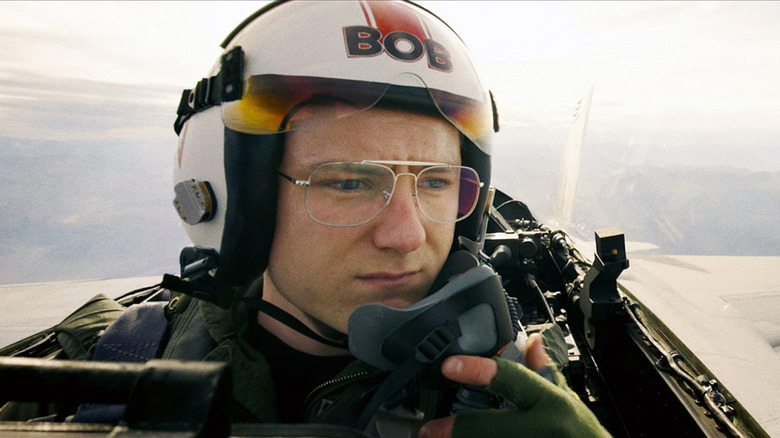The Meaning Behind Every Top Gun: Maverick Call Sign
With "Top Gun: Maverick" continuing to deliver at the box office, it's clear the film is far more than your garden variety dad flick. It's, at the risk of hyperbolizing, kind of a flawless film, one that exceeds its "dudes going fast in planes" conceit. Among other things, it's reignited an interest in call signs, the names that pilots adopt for their exploits in the air. A call sign can spring from a disparaging nickname or a notorious reputation, or it could speak to a pilot's particular skill and style.
"Maverick" introduced a handful of new call signs to the world of the films, and if you're a "Top Gun" die-hard, you've probably wondered how each character got their specific call sign. Fortunately, most of the "Maverick" cast has revealed a bit about their respective monikers, especially those that started out with entirely different ones. Let's break down each of the new call signs in "Top Gun: Maverick," and how each of them came to be.
Bradley 'Rooster' Bradshaw
Lt. Bradley "Rooster" Bradshaw (Miles Teller) has one of the more straightforward call signs in "Top Gun: Maverick" — but according to the New York Times, the character nearly had a very different name altogether. Back when Teller auditioned for Bradshaw, he was called "Rascal." An interesting choice, but not one that particularly fit the character that Rooster became. Fortunately, Teller was able to choose a new call sign after he was cast, one that served as a nod to his late on-screen dad, Goose (Anthony Edwards).
"Rooster did just kind of come to me," Teller told USA Today. "I remember meeting with Joe Kosinski, our director, and [producer Jerry] Bruckheimer, and they went through thousands of call signs." Only a few of them were bird-related, apparently. But Teller chose "Rooster" because it was similar enough to "Goose" without making an overt connection to the character. It begs the question, though: is there a universe where Bradshaw's call sign serves as a dead-on allusion to his dad's? Lt. Bradley "Gosling" Bradshaw has a nice ring to it.
Jake 'Hangman' Seresin
Hangman (Glen Powell) is to Rooster what Iceman was to Maverick in the original "Top Gun." Though his role in the sequel is decidedly clear-cut, it took a lot of work to create Hangman as we know him now. Originally, the character (call sign "Slayer") was a less-dimensional copy of Iceman. It's one of the things that kept Powell from auditioning at first, but once Cruise himself intervened, and the necessary tweaks were made to give the character some nuance, everything fell into place.
Seresin's call sign was one of the more minor changes that Powell, Kosinski and writer Christopher McQuarrie made, but it's also one of the more interesting behind-the-scenes anecdotes. In an interview with CinemaBlend, Powell revealed that the call sign "Slayer" didn't exactly fit in with other Navy call signs. "In the first Navy briefing, they were like, 'You know, these are Air Force call signs, and these are Navy call signs. There are Air Force call signs like Slayer and Spine Ripper.' And I was like, 'Well, I gotta change this! This is an Air Force call sign,'" Powell shared.
Powell found unique inspiration in the story of a Naval aviator he met in San Diego. "I met this one guy whose callsign was 'Noose,'" he later told Jimmy Kimmel. The way he earned that particular moniker is a "you had to be there" moment in itself, but it provided Powell with the necessary inspiration for his own call sign. "'Noose' became 'Hangman,'" he explained, and the rest is history.
Natasha 'Phoenix' Trace
As one of very few female fighter pilots in "Maverick," it's easy to infer what the call sign "Phoenix" means to Lt. Natasha Trace (Monica Barbaro). It wasn't until 1993 that women were allowed to fly in combat in the military, and a lot of the stigma that women faced then is still influencing the culture now. In the world of "Top Gun" — a world of machismo, fragile egos and equally-precarious missions — Phoenix arguably had to work time and again to prove herself. To end up as one of the most competent pilots in the Navy obviously speaks to her determination, a fact that her call sign effortlessly corroborates.
Barbaro is one of a few "Maverick" cast members that worked to make her character's call sign her own. "The call signs existed before us," she told The Hollywood Reporter, "but we grew into them in a beautiful way." While she and the rest of the new recruits had the option to pitch a different call sign than those laid out in the script, Barbaro found a way to "earn" hers after one night out with the cast. "I had a pretty intense night of frivolity, we'll say, and I rose from the ashes the next day."
Reuben 'Payback' Fitch
Not unlike Monica Barbaro, Jay Ellis found that his character's call sign was pretty fitting from the start. "I remember just going, 'I love Payback! There's nothing better. I'm coming for payback!'" the actor told USA Today. Like "Maverick" or "Stinger," the call sign more or less speaks for itself. And in terms of cool points, one could do a lot worse than Payback. But Ellis still managed to connect with his character's call sign on a personal level, albeit in a roundabout way.
On their first night together, the "Maverick" recruits met up with a few real-life Top Gun pilots at a Navy bar in Nevada, and the actors chose that particular night to get into character. "We go out with all the officers," Ellis told Insider. "Lewis [Pullman] doesn't speak to us the entire night. He was a total B.O.B." The cast assumed that Pullman was going method (he was actually just nervous). Either way, Ellis got into character his own way, and it involved a particular faux pas featured in the film.
"There was a moment in the night when I got Lewis' phone," Ellis explained. Anyone who's seen "Maverick" can only guess what happened next: "In the Navy, if you set your phone on a bar you have to buy drinks for the entire bar." That left Pullman buying drinks for everyone present that night — but Ellis lived up to his call sign by eventually paying his co-star back.
Mickey 'Fanboy' Garcia
Not unlike Phoenix and Payback, the call sign "Fanboy" is more or less straightforward. It's clear that Lt. Mickey Garcia (Danny Ramirez) likes to geek out about something — but what could that be specifically? Eagle-eyed "Star Trek" fans might have noticed the font on Fanboy's helmet, which is similar enough to the font used in the beloved franchise. Could Fanboy's call sign be alluding to his status as a hardcore Trekkie? According to Ramirez, that was director Joseph Kosinski's intention. But the actor also spoke with ComicBook.com about making the call sign a bit more personal for him.
"One of the first experiences that Glen [Powell] invited me on was a Jonas Brothers concert," Ramirez explained. Powell himself has been close with the Jo Bros after starring with Nick Jonas in "Scream Queens," so he's not exactly a hardcore stan. Still, there was something about becoming "a boy band fanatic" that Ramirez found interesting.
"I think him taking me to that concert only solidified Fanboy in like, 'Oh, it'll be fun if we're in the lockers, and for whatever reason my bag spills open and it's just like BTS, Jonas Brothers, whatever CD came out [of] that.'"
It's kind of an inspired idea. As BTS continues to open doors for this next generation of boy bands, fanboys become more and more common, even in the least likely places. Fanboy's "Trek"-inspired helmet could very well be a misdirection: What if he's actually an ARMY? If there's ever a "Top Gun 3," let's hope they explore this in detail.
Javy 'Coyote' Machado
"Coyote" is yet another cool-sounding call sign that benefitted from a bit of a backstory. Greg Tarzan Davis also spoke to ComicBook.com about the origin story he built for his character. As coyotes are comparatively smaller than their relatives, wolves, Davis imagined his character as an underdog. "He had to scrap for everything," he said, "and that's how he got the name Coyote."
With so many characters and dynamics to get right, it's a shame that not everyone's backstory could be explored in much detail. That said, it's a massive testament to the actors that did the work to beef up their characters where they could. Again, if there's a sequel on the horizon — however far off that horizon may be — it'd be great to learn a bit more about characters like Coyote (and Manny Jacinto's character — seriously, what was the deal with that?).
Robert 'Bob' Floyd
The story behind Robert "Bob" Floyd (Lewis Pullman) is the one quasi-mystery left of the core "Maverick" pilots. On one level, Bob's call sign serves as a cheeky bit of characterization. According to Pullman, Bob is "a hard nut to crack," though not through any fault of his own. He's a straightforward guy, but he doesn't necessarily fit into the ego-driven culture that dominates at Top Gun. Still, is there actually more to his moniker than meets the eye?
The beauty of a call sign like "Bob" is that it could easily serve as an acronym, as established by Hangman early in "Maverick." In the final version of the film, Hangman jokes that Bob's call sign might actually stand for "Baby on Board" — but that particular scene almost played out a lot differently. "One of the original drafts had this moment where he kind of earned his stripes," Pullman told the New York Times, "and Hangman says, 'I think I know what Bob stands for: Big Ol' Balls.'"
Ultimately, that scene was cut, but it still informed a core part of Bob's characterization. "He starts out as this unassuming guy, who then finds his strength." That, or it was always there — it just took a while for his fellow Top Gun recruits to see it. Either way, the ambiguity of Bob's call sign helped to create one of the most interesting characters in "Maverick." Characters like Hangman may see what they want to see in Bob, but ultimately, he's an open book, and his call sign (while not overly creative) reflects that perfectly.
